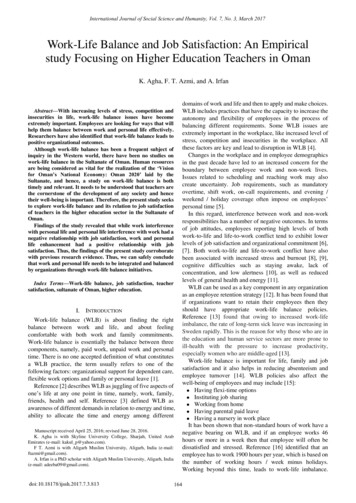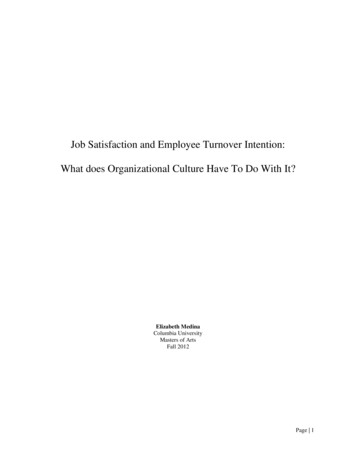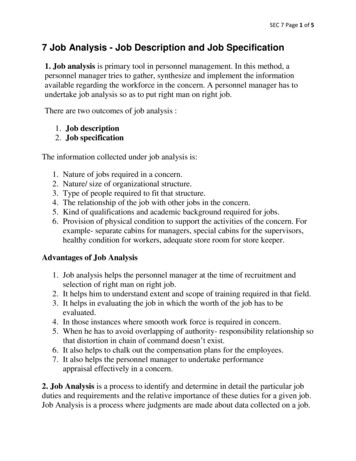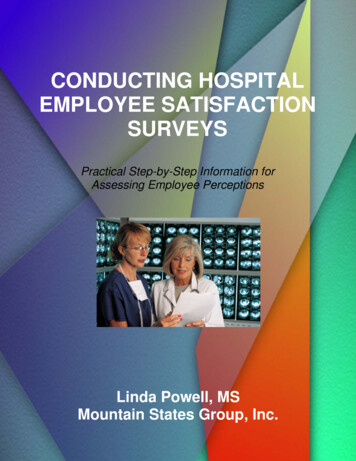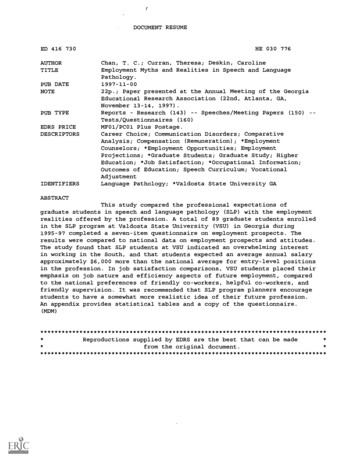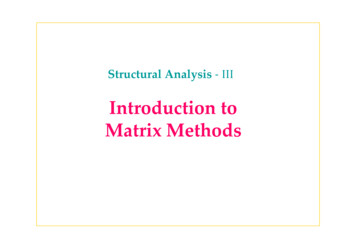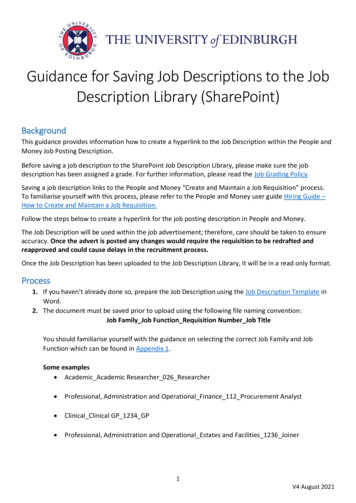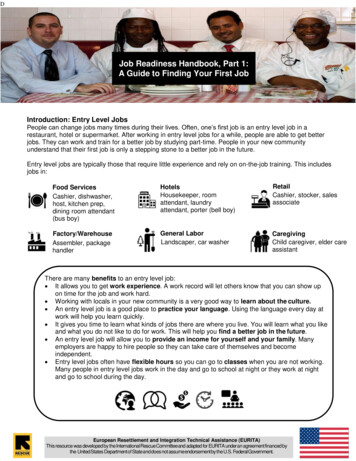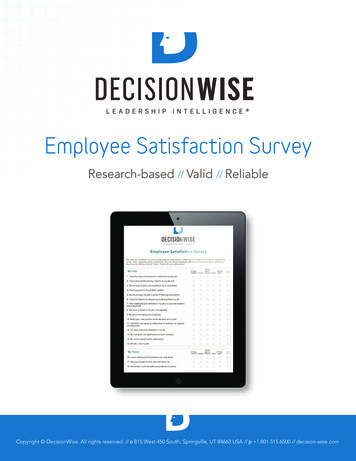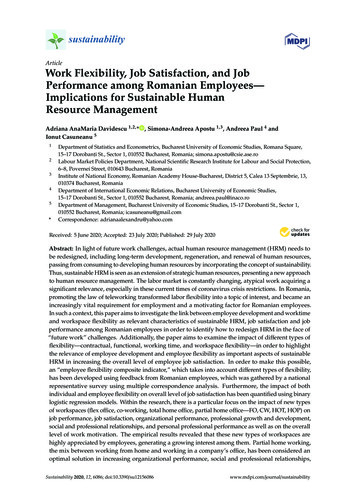
Transcription
sustainabilityArticleWork Flexibility, Job Satisfaction, and JobPerformance among Romanian Employees—Implications for Sustainable HumanResource ManagementAdriana AnaMaria Davidescu 1,2, * , Simona-Andreea Apostu 1,3 , Andreea Paul 4 andIonut Casuneanu 512345*Department of Statistics and Econometrics, Bucharest University of Economic Studies, Romana Square,15–17 Dorobant, i St., Sector 1, 010552 Bucharest, Romania; simona.apostu@csie.ase.roLabour Market Policies Department, National Scientific Research Institute for Labour and Social Protection,6–8, Povernei Street, 010643 Bucharest, RomaniaInstitute of National Economy, Romanian Academy House-Bucharest, District 5, Calea 13 Septembrie, 13,010374 Bucharest, RomaniaDepartment of International Economic Relations, Bucharest University of Economic Studies,15–17 Dorobanti St., Sector 1, 010552 Bucharest, Romania; andreea.paul@inaco.roDepartment of Management, Bucharest University of Economic Studies, 15–17 Dorobanti St., Sector 1,010552 Bucharest, Romania; icasuneanu@gmail.comCorrespondence: adrianaalexandru@yahoo.comReceived: 5 June 2020; Accepted: 23 July 2020; Published: 29 July 2020 Abstract: In light of future work challenges, actual human resource management (HRM) needs tobe redesigned, including long-term development, regeneration, and renewal of human resources,passing from consuming to developing human resources by incorporating the concept of sustainability.Thus, sustainable HRM is seen as an extension of strategic human resources, presenting a new approachto human resource management. The labor market is constantly changing, atypical work acquiring asignificant relevance, especially in these current times of coronavirus crisis restrictions. In Romania,promoting the law of teleworking transformed labor flexibility into a topic of interest, and became anincreasingly vital requirement for employment and a motivating factor for Romanian employees.In such a context, this paper aims to investigate the link between employee development and worktimeand workspace flexibility as relevant characteristics of sustainable HRM, job satisfaction and jobperformance among Romanian employees in order to identify how to redesign HRM in the face of“future work” challenges. Additionally, the paper aims to examine the impact of different types offlexibility—contractual, functional, working time, and workspace flexibility—in order to highlightthe relevance of employee development and employee flexibility as important aspects of sustainableHRM in increasing the overall level of employee job satisfaction. In order to make this possible,an “employee flexibility composite indicator,” which takes into account different types of flexibility,has been developed using feedback from Romanian employees, which was gathered by a nationalrepresentative survey using multiple correspondence analysis. Furthermore, the impact of bothindividual and employee flexibility on overall level of job satisfaction has been quantified using binarylogistic regression models. Within the research, there is a particular focus on the impact of new typesof workspaces (flex office, co-working, total home office, partial home office—FO, CW, HOT, HOP) onjob performance, job satisfaction, organizational performance, professional growth and development,social and professional relationships, and personal professional performance as well as on the overalllevel of work motivation. The empirical results revealed that these new types of workspaces arehighly appreciated by employees, generating a growing interest among them. Partial home working,the mix between working from home and working in a company’s office, has been considered anoptimal solution in increasing organizational performance, social and professional relationships,Sustainability 2020, 12, 6086; ability
Sustainability 2020, 12, 60862 of 53learning and personal development, and the overall level of work motivation. The results of themultiple correspondence analysis highlighted a medium level of flexibility among those Romanianemployees interviewed, with only one third of them exhibiting high levels of flexibility. The empiricalanalysis of logistic regression analysis pointed out the role of functional flexibility, working time,and workspace flexibility along with the flexibility composite indicator in increasing the level ofjob satisfaction in employees. Therefore, if the challenge is to redesign the actual human resourcemanagement in order to include the concept of sustainability, attention needs to be on a combinationof employee development-flexible time and flexible places, leading to an increase in both employeejob satisfaction and organizational performance as important outcomes of sustainable HRM.Keywords: sustainable human resource management; work flexibility; job satisfaction;job performance; Romania; employee survey; composite indicator; multiple correspondence analysis;logistic regression analysis; new types of workspaces1. IntroductionEmployees are key stakeholders in the formation and development of the organisation’s human andsocial capital and are a key source of knowledge and support for the development and implementationof sustainable human resource management (HRM). In the face of current challenges, the concept ofHRM needs to be redefined, with sustainable HRM being a more appropriate approach to actual humanresource management. Sustainable HRM’s aims is for long-term objectives and results, with a focus onemployee and environmental care, employee participation and development, external partnership,flexibility, compliance with labor regulations, cooperation between employees, equity, and equality,all without affecting profitability.Among the main characteristics of sustainable HRM, the two core characteristics—employeedevelopment and a combination of flexible working time and new types of workspaces—are particularlyimportant in terms of their impact on the two main outcomes of sustainable HRM—job satisfactionand job performance.The labor market is constantly changing, and the role of the employee is incredibly important.When employees are able to choose their preferred working hours, they tend to be more motivatedand spend a longer period of time without changing jobs. In recent years, this paradigm shift resultedin an increase in employee autonomy, interruptions during work schedules to meet employee needs,employee participation in decision making, workspace modelling, and increasing employee creativityand productivity. Sustainable HR practices are largely influenced by the level of job performance andsatisfaction; therefore, in-depth knowledge of these factors is essential in redefining HRM according tocurrent needs.Work flexibility offers employees a balance between their professional and personal lives,leading to job satisfaction and high performance and an overall improvement of the organizationas a whole. Work flexibility is very important, and with digital advancements and improvedtechnology, employees are able to continue their work anywhere they wish, provided they have aninternet connection.Atypical job roles have become significantly more common, especially characterized today by therestrictions caused by the coronavirus crisis. Although full-time permanent employment representsmost of today’s workforce, the increasing prevalence of non-standardized forms of employmenthas brought structural change to work patterns, most likely resulting in a change to employee jobsatisfaction levels, providing information that could be incredibly valuable to us.In Romania, promoting the law of teleworking transformed labor flexibility into a topic of interest,becoming an increasingly essential condition required for employment and a motivating factor forRomanian employees.
Sustainability 2020, 12, 60863 of 53In such a context, this paper aims to investigate the link between employee development andworktime and workspace flexibility as relevant characteristics of sustainable HRM, job satisfaction,and job performance among Romanian employees in order to identify how to redesign HRM in theface of ‘future work’ challenges. Furthermore, the paper aims to examine the impact of different typesof flexible contracts, functional, working hours, and workspace flexibility in order to highlight therelevance of employee development and employee flexibility as important aspects of sustainable HRMin increasing the overall level of employee job satisfaction.Could different forms of work flexibility lead to an increase in job satisfaction and job performance?This is the main question of our research. In attempting to answer to this question, the empiricalanalysis will be structured on three levels. On the first level, we will examine the main characteristicsof both job satisfaction and work flexibility among Romanian employees, highlighting the impactof new forms of workspace flexibility on job performance, job satisfaction, personal time and spacemanagement, level of comfort, level of organizational performance, level of personal and professionalrelationships, level of professional development, and the overall level of work motivation.First, we will investigate the key differences regarding the main forms of work flexibilityamong Romanian employees, focusing particularly on contractual flexibility, working time flexibility,functional flexibility, and workspace flexibility. Second, we will identify the main determinants of workflexibility for Romanian employees and build a composite flexibility indicator using the results fromthe multiple correspondence analysis (MCA). Finally, we will investigate both the potential impact ofthe composite flexibility indicator and the impact of individual flexibility forms on the overall level ofjob satisfaction of Romanian employees using the binary logistic regression model, revealing its mainimplications for achieving the desideratum of sustainable HRM.This paper contributes to the sustainable HRM literature in several ways. First, it analyses theimpact of two important characteristics of sustainable HRM employee development and worktime andworkspace flexibility, grounded in an evidence-based approach on two major outcomes of sustainableHRM (job satisfaction and job performance), contributing to the diminution of the gap in scientificknowledge especially at a national level. Second, the paper offers a first attempt at investigating theimpact of the new forms of workspaces on job performance, job satisfaction, personal time and spacemanagement, level of comfort, level of organizational performance, level of personal and professionalrelationships, level of professional development, and the overall level of work motivation. This isparticularly important when taking into account the restrictions regarding social distancing in thecontext of the current health crisis. Third, the paper considers a multi-dimensional approach of workflexibility from the perspective of working time and workspaces as well as employee development,which is considered to be an important characteristic of sustainable HRM. Fourth, the paper provides,to our knowledge, a first composite measure of work flexibility seen from different angles at anindividual level that offers a global view of the main elements of flexibility present within Romanianorganizations. Furthermore, the paper analyzes how this synthetic measure impacts employee jobsatisfaction as an important outcome of sustainable HRM, thus highlighting the way in which theHRM needs to be redesigned.The paper is organized in the following sections. Section 1 represents the introduction,highlighting the relevance of the topic and the main aim of our research. Section 2, the literature reviewhas been organized into four main sub-sections and starts with an introductory section on sustainableHRM presenting the main conclusions from the literature regarding job satisfaction, work flexibility,and sustainable HRM and a short presentation of the particularities of work flexibility in times ofcrisis. Sections 2.2–2.4 present the most relevant conclusions from literature regarding the relationshipbetween work flexibility and job satisfaction, work flexibility and job performance, as well as workflexibility and a combination of the two.Section 3 is dedicated to the presentation of survey design, some theoretical considerations,the methodology, and the data.
Sustainability 2020, 12, 60864 of 53Section 4 is dedicated to empirical results and it is divided into seven sub-sections. The first isdedicated to the presentation of a profile of Romanian employees profile, while the next two present themain characteristics of job satisfaction and work flexibility among Romanian employees. Analysis ofthe impact of new forms of workspace flexibility on job satisfaction, job performance, personal timeand space management, level of comfort, level of organizational performance, level of personal andprofessional relationships, level of professional development, and the overall level of work motivation.Section 4.5 presents the main differences among Romanian employees regarding different forms ofwork flexibility, and Section 4.6 is dedicated exclusively to the development of a composite indicatorof Romanian employee flexibility using multiple correspondence analysis. The last sub-section triesto respond to the following question, “Does flexible working increase job satisfaction?” to capturethe impact of both the flexibility composite indicator and the individual forms of work flexibilityon job satisfaction using the binomial logistic regression models emphasizing the main implicationsfor achieving sustainable HRM desideratum. The paper ends with main conclusions and policyimplications, which are considered fundamental in the process of redesigning HRM in the face of“future work” challenges.2. Theoretical Considerations and Hypothesis Development2.1. Sustainable Human Resource Management LiteratureEmployees are key stakeholders in the formation and development of the organisation’s human andsocial capital and are a key source of knowledge and support for the development and implementationof sustainable HRM. The employees are one of the most important stakeholders in an organization andthe organization as a whole is a stakeholder of HRM.In a volatile labor market, it is becoming increasingly important to change the prevailing situationwhere human resources are consumed rather than developed, if the focus is to increase the retention ofemployees. In this endeavor, sustainable HRM has been included as a response to changes regardingsocietal levels, labor market, and employment relations. Sustainable HRM represents an extensionof strategic HRM and presents a new approach to people management [1], being seen as a possiblesolution to lead humanity back into HRM [2], while sustainability refers to resource regeneration,development, and renewal. However, the difference between strategic and sustainable HRM implieslarger aims; while strategic HRM is determined by organizational performance, mainly in terms ofeconomic outcomes, sustainable HRM also considers social human, environmental, and financialoutcomes [1].In terms of sustainability, it represents a survival strategy for organizations to arrange systemswhere employees would have (a) the intention to work for a particular organization, (b) the capabilityto perform tasks in a proper manner for business, and (c) the possibility to work toward better health,lower stress, or a work–life balance [3].Sustainable HRM is the result of various disciplines and research areas, focusing on corporatesustainability and social responsibility and sustainable work systems. It respects the classic concepts andpractices regarding strategic management of human resources from the private sector [4]. Most HRMmodels present the concept of work flexibility as having a direct and significant influence on themanagement of people in organizations [5].It has a wide scope, involving the creation of adequate working conditions, sustainable leadership,cooperation and teamwork, diversity and multiculturalism, ethics and governance, value creation andinculcation, health and safety, workforce involvement, and a sustainable environment [6]. Sustainabilitycan be used as a principle for HRM itself and the tasks of sustainable HRM are twofold. First, it cultivatesthe conditions for personal employee sustainability and advances the ability of HRM systems toregularly attract, regenerate and develop motivated and engaged employees by sustainably buildingthe HRM system itself [3].
Sustainability 2020, 12, 60865 of 53Esfahani et al. investigated the important features of a sustainable HRM in innovative organizationsto identify the relationship between psychological capital, human resource flexibility, and sustainableHRM [7]. They examined HRM in innovative organizations that can benefit from psychological capitaland flexibility of human resources, with the results indicating that flexibility and functional optimismof human resources significantly influenced the sustainability of human resources. Kazlauskaite andBuciuniene [8] strongly believed that, in order to achieve and support the sustainable competitiveadvantage, companies need to have unique, valuable, and inimitable employees.A relevant contribution to the literature concerns the proposal made by Stankeviciute andSavaneviciene [1] identifying 11 characteristics of sustainable HRM—long-term orientation, care ofemployees, care of the environment, profitability, employee participation and social dialogue,employee development, external partnership, flexibility, compliance beyond labor regulations,employee cooperation, fairness, and equality. From all these characteristics, employee developmentand flexibility affect overall level of job satisfaction, which is the subject matter of our research.In designing sustainable HRM, Cohen et al. [9] mentioned three characteristics—equity, well-being,and employee development—and the study is particularly relevant for our research in terms of thelast factor.Zaugg [10] have taken into account the following characteristics of sustainable HRM: flexibility,employee participation, value orientation, strategy orientation, competency and knowledge orientation,stakeholder orientation, and building mutually trustful employee–employer relationships. Park [11]associated six themes with sustainable HRM—a diverse workforce, employees’ development, flexibility,volunteer work, employees’ health, and green HRM.A model of sustainable HRM and organizational performance was proposed by Nyameh [12],highlighting the role of training, rewards, and participation on sustainable HRM outcomes, such asemployee satisfaction, employee motivation, and employee retention or loyalty.Stankevičiūtė and Savanevičienė [1] argued that sustainable HRM reduces the negative impactof HRM on employees and contributing to employee wellbeing by decreasing work-related stress,work-family conflict, and burnout.HRM practices lead to attracting, motivating, and retaining employees to ensure the survival ofthe organization [13]. This practice considers that human capital plays a significant role in achievingthe organization’s goals [14], being positively correlated with the employee engagement if usedproperly [15]. HRM practices are influenced by organizational performance and improve employeewell-being through job satisfaction and organizational commitment [16]. Other HRM practices suchas training and development and performance assessment encourage the employees to work better,thus increasing the organizational performance [17]. Training gives employees the opportunity toobtain knowledge and skills that can help them achieve their responsibilities adequately, resulting inimproved performance [18]. The characteristics of sustainable HRM affect employee satisfaction;therefore, to ensure sustainability and increase the efficiency of the organization, it is necessary to meetthe needs of employees who benefit from good working conditions [1].Figure 1 highlights the most relevant studies focusing on work flexibility, job satisfaction and jobperformance, and also studies at the intersection of these three relevant topics. Table 1 presents anoverview of the most relevant studies regarding work flexibility, job satisfaction, and job performanceat a national level.In order to increase business efficiency, competitiveness, success, and to ensure sustainability,it is commonly agreed that the focus needs to also be on satisfying the needs of employees byproviding them with good working conditions [19–21]. Additionally, Al Mamun et al. [22], Cantele andZardini [23], Delmas and Pekovic [24], Pintão et al. [25], and Dongho [26] reinforced the core importanceof employee satisfaction and the fact that their productivity crucially impacts the company’s success orfailure. An increase in the overall level of employee satisfaction also increases the level of retention.Work environment and working conditions are very important in this context. The ideal situation is foremployees to be satisfied with their conditions and work environment [27–29]. The importance of
Sustainability 2020, 12, 60866 of 53work environment in terms of enhancing satisfaction and motivation of employees, while increasingcorporate sustainability performance, has been highlighted by Chang et al. [30], Chatterjee et al. [31],Gianni et al. [32], Roxas et al. [33], and Chandrasekar [34].Sustainability 2020, 12, x FOR PEER REVIEW6 of 56FigureTheconceptualconceptual frameworktheoreticalconsiderationsbetweenwork flexibility,jobFigure1. 1.Theframeworkof oftheoreticalconsiderationsbetweenwork flexibility,satisfaction, and job performance.job satisfaction, and job performance.In order to increase business efficiency, competitiveness, success, and to ensure sustainability, itStrenitzerová and Achimsky [6] offer a new perspective of the achievement of employee satisfactionis commonly agreed that the focus needs to also be on satisfying the needs of employees by providingand loyalty as part of sustainable human resource management, revealing that higher financialthem with good working conditions [19–21]. Additionally, Al Mamun et al. [22], Cantele and Zardinirewardsto andthe s’age, jobtheposition,and length[23], leadDelmasPintão et al.while[25], and[26] reinforcedcore importanceof e satisfaction and the fact that their productivity crucially impacts the company’s success orsincefailure.employeesatisfactionseen asa keychallengesatisfactionfor sustainablehuman theresourceAn increasein theisoveralllevelof employeealso increaseslevel ofmanagement.retention.Work environmentand workingconditionsbetweenare very jobimportantin this employeecontext. Theideal situationGiovanis[35] exploredthe relationshipsatisfaction,loyalty,and twoistypesfor employeesto be satisfiedwith their conditions andandworkenvironment[27–29]. The importanceof letiming—revealinga geffect from these employment arrangements on job satisfaction and employee loyalty. Also, our researchsustainabilityperformance,has beenhighlightedChang et al.and[30],jobChatterjeeet al. [31],treatscorporatethe relationshipbetweendifferentformsof workbyflexibilitysatisfactionamongGianni et al. [32], Roxas et al. [33], and Chandrasekar [34].Romanian employees.Strenitzerová and Achimsky [6] offer a new perspective of the achievement of employee satisfactionAnalyzing different forms of employment and their relationship with employee loyalty,and loyalty as part of sustainable human resource management, revealing that higher financial rewardsKot-Radojewskaand satisfaction,Timenko [36]providedevidencethe employeesan indefinitedurationlead to the greatestwhilethe employees’age, thatjob position,and lengthwithof teda higherlevelof loyaltycomparedthose sincewith employeea fixed-termimpact employeeThe resultspresenta particularinterestfor our so resourcebe includedin our research, but with ansatisfactioncontract.is seen as aThiskey challengesustainablemanagement.[35] explored the relationship between job satisfaction, employee loyalty, and twoimpact onGiovanisjob kingand flexibletiming—revealinga positive andAlthough thereemploymentis an extensivebody of literature writtenof jobsatisfaction, sonjobsatisfactionandemployeeloyalty.Also,Tansel [37] provide an interesting analysis of the determinants of job satisfaction in Britain he following four different measures of job satisfaction: satisfaction with their influence over theamong Romanian employees.job, satisfaction with the amount of pay received, satisfaction with the sense of achievement gained,Analyzing different forms of employment and their relationship with employee loyalty, Kotand satisfaction with the level of respect given from supervisors. Among the interesting resultsRadojewska and Timenko [36] provided evidence that the employees with an indefinite durationobtained,and takingintoexhibitedaccountatheaimlevelof ourthey foundthatwithlonga workingemploymentcontracthigherof research,loyalty comparedto mployeeswhohadjobtrainingweremoresatisfiedthan thoseemployment contract. This relevant finding will also be included in our research, but with an impactwho rerelevantfromtheperspectiveofjob satisfaction.
Sustainability 2020, 12, 60867 of 53working time and functional flexibility and led us to research how these characteristics affect Romanianemployee satisfaction.Flexibility is an important characteristic of sustainable HRM [1,11] that primarily reflects the needsof employees. Sustainability in the field of human resources and its benefits imply a broader approachto labor regulations, as compliance with institutional requirements does not lead to sustainability [38].It represents the capability of organizations to confront the dynamics and uncertainty of theirenvironments, rapidly changing their organizational routines or resource bases.Work flexibility and its implementation have occupied an important place in the last few decadesin industrial sociology and human resource management, becoming a popular term in many fields anddirections of research, presented as a necessity in the contemporary workplace [39]. Since organizationalenvironments have become more complex and dynamic, companies increasingly use HRM practicesthat enhance their flexibility, such as contingent work, part-time or temporary work, and flexiblecontract work [40].From the perspective of employees’ initiatives regarding the work they performed or the waythey are employed, Reilly [41] proposed five types of work flexibility—functional, numerical, temporal,local, and financial. An alternative classification of work flexibility arrangements have been proposedby the International Classification for Standards, according to which there are two types of workflexibility—on the one hand, there is a quantitative flexibility (involving changes regarding the numberof employees and working hours), and on the other hand, there is a qualitative flexibility (involvingthe content of competence and quality of work) [42].Among the main characteristics of sustainable HRM pointed out by Stankeviciute andSavaneviciene [1], two core characteristics are of particular interest for our research—employeedevelopment and a mix of flexible working time, and new types of workspaces to increase jobsatisfaction leading to sustainable HRM. Casuneanu identified the following four different formsof work flexibility: working time flexibility, contractual flexibility, functional flexibility (vocationaltraining), and wage flexibility [43].In light of sustainability, functional flexibility achieved through employee development is evenmore important from the perspective of acquiring of skills and developing capacities that employeeswill need in the future. Thus, the development of employees needs to take into account the investmentin future skills, and the employees’ need to be regarded as two facets: the main asset as well as anagent of change [1]. Hirsig et al. [44] argue that, “it becomes more and more important to invest incontinuous training and education for the workforce rather than in infrastructure and equipment.”Hirsig et al. [44] and Stankevičiūtė and Savanevičie [1] highlighted the importance of investmentin training and education for human resources, creating a win–win situation both for employees (futureemployability and career opportunities) and for employer (profitability and success).The presence of sustainability in HRM can be revealed through employee development throughon the job training, which can be seen as a cost-saving approach, leading in turn to higher jobmotivation [45] as well as through mentoring and sharing the knowledge with new employees [46],sending the message that through training and development, the company is interested in their longterm retention. Employee development can be seen also as a mechanism for helping individuals inachieving their own self-development and self-enrichment goals or as learning opportunities seen as a“sustainable” investment in personnel [46,47]. In conclusion, employees’ development is regardedas an important element of sustainable HRM and represents an important aspect of our research,aiming
Sustainability 2020, 12, 6086 3 of 53 In such a context, this paper aims to investigate the link between employee development and worktime and workspace flexibility as relevant characteristics of sustainable HRM, job satisfaction,
